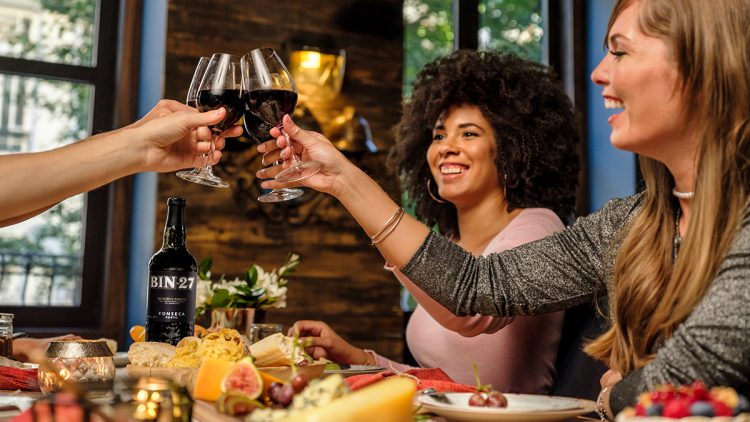When you think about port wine, you may think about dessert time. A little sip while you indulge in a chocolate cake or maybe a tawny nightcap. Well, port is so much more than that.
White or ruby port — on ice or mixed with tonic water — makes the perfect low-ABV aperitif. And a special vintage port may give your palate an experience it didn’t know it needed. In fact, you can drink port throughout your meal from beginning to end and be hard-pressed to find a meal the wine did not complement.
We spoke to Adrian Bridge, CEO of the Taylor Fladgate Partnership, about port wine for beginners, port cocktails and the difference in aged port wine so you know exactly what to order for dessert.
The Gourmet Insider: If you’ve never had port wine before, what should you start with? What should you expect from your first port tasting?
Adrian Bridge: The best introduction to port is probably through the Reserve Ruby style, like Bin 27. It has lovely fresh fruit flavors of blackcurrant, blackberry and plums with hints of dark chocolate. It is easy to drink and accompanies many desserts — or is a dessert on its own. You will be rewarded with a rich mouthful of flavors and you will probably not even notice that the alcohol in port is about 50% higher than red table wine.
TGI: What is the difference in aged ports, from 10, 20, 30 and older?
AB: During the aging in wooden cask, the wine gradually takes on amber characteristic ‘tawny’ color, slowly developing the complex mellow flavors and the smooth luscious palate which are the hallmarks of tawny port. Decades of evaporation have concentrated this extraordinary wine to an exceptional density, with a powerful nose of dried fruit, honey and a touch of spice. Impressions of nutmeg, roasted coffee and an intense nuttiness converge both in the bouquet and on the palate. The wine’s rich, intense, voluptuous, almost viscous texture culminate in a finish of incredible length.
As they age they become more concentrated because of the evaporation — we lose about 3% a year. So, to make a liter of 20-year-old tawny, you have to start with two. That concentration is what gives the layers of flavor and structure — but adds to the price.
TGI: Many people feel that port is a dessert wine, but it isn’t by any means. Can you speak to some of the flavor notes and how else people should use them?
AB: Contrasting flavor is just one part of the wonderful experience with port wine. White ports are amazing aperitifs, are the perfect drink on a warm summer’s day with some salted almonds and some hand cut crisps. Full bodied and fruity ports, such as First Estate and Late Bottled Vintage, cry out for a cheeseboard.
Aged tawny ports with their characteristic mellow spicy, nutty and oaky aromas, silky palate and opulent flavors should be paired with an almond tart, pecan pie, crème brûlée, or better than that, an apple crumble with some vanilla ice-cream. A glass of chilled 10- year-old makes a delicious aperitif. A 20-year-old aged tawny port has a wonderful acidity to the wine and pairs beautifully with foie gras and brioche at the beginning of a fine dinner.
As to vintage port, simply savor the rich and complex flavors of the wine on their own in a generously proportioned glass with good company.
TGI: What is the main difference between oak aged and bottle-aged ports?
AB: Vintage port aged in bottle meaning that the aging process occurs without contact with the air. This wines are renowned for their massive structure and aromatic power, tempered by a characteristic understatement and restraint. They have the ability to age for decades in bottle, slowly developing an extreme elegance and harmony.
Tawny ports mature in oak cask thus in contact with the air and will evolve differently than one which ages in bottle and has almost no air contact. The firm tannins and intense fruity flavors of youth gradually give way to the velvety smoothness and mellow, nuanced character which develop with age. At the same time there is a change in the wine’s appearance, its initial deep red color slowly becoming paler and evolving into the subtle amber.
TGI: If you are a beginner, should you pair your port with food or should you sip it neat to get the flavor? Both?
AB: Both. Treat port wine as a friend you will discover more and more with time and confidence. But, make sure to always serve your port wine in the correct glass and at the correct temperature for the best experience.
TGI: What is one thing you feel is a preconceived notion about Port and what would you want people to know?
AB: As port is from the Douro valley and is the oldest demarcated wine region it has many traditions and has a long history. People sometimes think that this means it is a drink for older people or more for males. This is definitely not true. There are many different styles of port so everyone can find their favorite. Port is one of the great classic wines and its history is a long and fascinating one.

